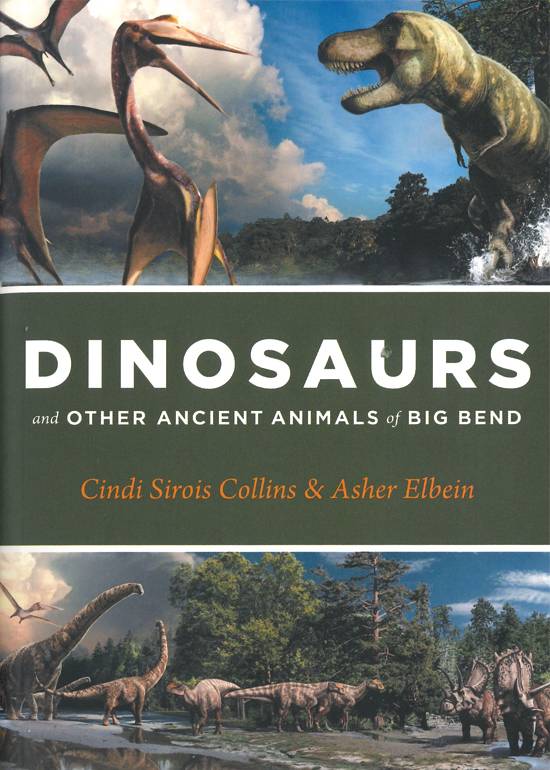An Excellent Compilation of Big Bend Vertebrate Paleontology

Dinosaurs and Other Ancient Animals of Big Bend
by Cindi Sirois Collins & Asher Elbein.
Austin: University of Texas Press, 2023.
240 pp. $24.95 Paperback.
Reviewed by
Brandon Radoman-Shaw
One of my first geologic fieldtrips in college was to Big Bend National Park. We spent the week camping and discussing the innumerable natural wonders of the region and its wildlife. This was in the summer of 2010, before this book was published and long before the Fossil Discovery Exhibit was opened in 2017. I still have my field book from that trip and reviewed it before reading the book. While it was not my most magnanimous work, I have entries on some of the formations and provided details on the Santa Elena Limestone and Boquillas Formation along with the volcanics in the area. If this resource was available at the time of our trip, I am certain it would have been among the required readings. For anyone interested in the vertebrate paleontology of the Big Bend Region, this is a great introduction that highlights important discoveries in the context of the evolving environments recorded in the kilometers of rock still preserved from the Cretaceous through to the Quaternary in Big Bend National Park.
The purpose of the book, succinctly discussed in the introductory chapters, is to collect the information and history of the scholarship and elucidation of the important discoveries and fossil finds within the boundaries of the park. This material has not been compiled in one book, and the authors have succeeded in collecting this information in one place with a voice appropriate for the lay-person and professional. It does not go into overwhelming detail into any of the finds; however, there is a compendium of more specific sources provided where the reader could find more information. The book’s primary focus is on large vertebrates as the name suggests, and there is little discussion of the microorganisms, plants or sedimentological data that provides future information about these environments. Though technical at times, this text would not substitute a college textbook on geological phenomenon or paleontological analysis. For most, this book successfully functions as an expert text to get anyone interested in geology and fossils.
The book is organized chronologically, starting with one of the major sedimentary units in the Middle Cretaceous period and continues to the Holocene epoch. It discusses dinosaurs in depth, as well as turtles, crocodilians, lizards, amphibians, fish, birds, mollusks, and mammals. After brief introductions on the geologic environment, the book functions like a field guide, with the common name, taxonomy, dimensions, natural history, and fossils specific to Big Bend. Information on organisms is supplemented by work done in other locations. For some organisms the fossil evidence in the park is minimal (teeth or bone fragments), however the authors do a great job using the available fossil evidence of all the fauna from a specific unit to build a picture of what the ecosystem would be like. The authors mention and use information from Oceans of Kansas, which provides a similar approach to the information, and it flows smoothly in each section. There are not many pictures of the actual fossils, but most entries come with an artist’s rendition of how the organism would have looked in life.
Some important fossil highlights specific to discoveries in Big Bend National Park that stand out in my memory after reading the book are: discovery and naming of the largest pterosaur ever discovered, Quetzalcoatlus northropi; fossilized skin impressions of Gryposaurus “duck-billed” dinosaur; discovery of a gigantic bone of Alamosaurus “long-necked” dinosaur; and the desiccated remains of twenty-seven California condors in a cave in the Chisos Mountains from over 12,000 years ago. There are many other interesting finds discussed, and this compendium of fossil discoveries itemized and catalogued is an important step in capturing and elucidating the ecosystems that existed in Texas and demonstrating the importance of protecting not only Big Bend National Park, but also other lands from development. There were many discoveries that changed our understanding of species richness and sheer size during the Cretaceous period and subsequent periods and epochs. Going chronologically through the archaeological history provides a stark contrast from the shallow Cretaceous seas, to forests, to the dry desert environment of today. Basically, a shift of millions of years from sharks to mammoths.
This book will appeal to readers wanting to know more about Big Bend National Park, but also about the late Mesozoic and Cenozoic geology of Texas and the Western United States. It is well edited and will inspire those visiting Big Bend National Park to become interested in the past and engage with the hundreds of millions of years of history that are in the park today.
Dr. Brandon Radoman-Shaw is a lecturer at Texas State University. He received his Bachelor of Science degree in geosciences from Trinity University in San Antonio, Texas, and his doctorate in geological sciences from Case Western Reserve University in Cleveland, Ohio. His main research focus is mineralogy and petrology, and he teaches physical geology, historical geology, and sedimentation and stratigraphy courses for the geology minor in the Department of Geography and Environmental Studies.
